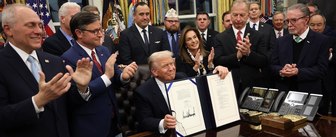Supporters of Donald Trump have been far more fired up than supporters of Joe Biden about their respective candidates in recent Economist/YouGov surveys and other polling. While the Trump campaign has highlighted this enthusiasm gap as “the most important factor” in the election, YouGov’s polling also shows that enthusiasm for a candidate is not the same as enthusiasm for voting, and the link to turnout is uncertain.
The gap in enthusiasm for the two candidates has remained constant in recent weeks along with Joe Biden’s lead. When we combine data from the Economist/YouGov trial heats in July, Biden leads Trump by the same nine percentage point margin (49% to 40%) as on the most recent survey. During July, better than two-thirds of Trump supporters (68%) felt “enthusiastic” about him compared to 40 percent of Biden supporters who felt the same about him. Enthusiasm for Biden has grown over the last month (from 31% in mid-June), but the large gap between the candidates on this measure remains.
Nevertheless, enthusiasm for each candidate is only part of the election equation. As YouGov’s June analysis pointed out, elections with an incumbent president seeking reelection are often about that incumbent, and in this case, nearly two-thirds (62%) of Biden voters in June said their vote was “mostly against Donald Trump.” While this number has fallen slightly on the July surveys (57%), the larger point remains: The lack of enthusiasm for Biden may mask the motivation his backers feel about voting against Trump.
Two additional questions asked on the Economist/YouGov tracking in July can help tease out the distinction between enthusiasm expressed for each candidate and for the entire election. A large majority of supporters of both candidates say they are extremely or very enthusiastic about “voting for President in the upcoming presidential election in November,” with the gap between Trump (76%) and Biden (69%) narrowed to seven percentage points (the gap on “extremely enthusiastic” is just six points; 56% among Trump supporters and 50% among Biden supporters).
On a slightly different question, nearly the same number of Trump and Biden supporters (55% and 53% respectively) say they are “more enthusiastic” about voting for president this year than in previous presidential elections. Trump appears to have another modest advantage in enthusiasm, especially when viewing the data by those who are “less enthusiastic” to vote this year compared with previous years: 18 percent of Biden supporters say they are less enthusiastic this year versus just 11 percent of Trump supporters who say the same.
Thus, emphasizing the election rather than the candidates narrows the apparent enthusiasm gap. A fourth question that omits the word enthusiasm altogether, asking “how important is voting for President this November,” erases the gap completely. Nearly nine out of ten registered voters consider voting very important, with no significant difference between Trump (91%) and Biden (92%) supporters.
These differences in expressed enthusiasm for each candidate, for the election and in the perceived importance of voting for president raise a critical question: which measure is more predictive of turnout?
Analysts at the Democratic polling firm Global Strategy Group found that questions on “motivation” to vote were better predictors of actual turnout (as validated by voting records) than questions on “excitement” about voting in elections in both 2018 and 2019. Their theory is that “motivation” captures a broader range of feeling than “excitement,” particularly when voters “are showing up to express dissatisfaction” with another candidate rather than just “showing up to vote for someone or to affirm something.” That distinction may be analogous to the expressions of “enthusiasm” and “importance” in regard to voting in the Economist/YouGov surveys.
More directly relevant: A recent CBS News analysis found a similar gap favoring Trump in expressed enthusiasm for voting in November in five battleground state polls conducted in July by YouGov. However, the analysis also noted the limitations of the enthusiasm question in projecting turnout. In 2018, CBS/YouGov polls found similar levels of enthusiasm among Republicans and Democrats, but recontact studies conducted after the election “found that their pre-election enthusiasm did little to predict whether they actually voted, at least after controlling for their self-reported likelihood of turning out.”
The recent CBS/YouGov battleground tracker survey also included a question on self-reported likelihood of turning out, and like the Economist/YouGov question on the importance of voting, it showed no significant gap between Trump and Biden supporters.
Our recent analysis showed that unenthusiastic Biden supporters – who were more likely to have preferred Bernie Sanders – favored Elizabeth Warren as a vice presidential nominee more than enthusiastic Biden backers. Her selection would likely boost good will for Biden among these less enthusiastic backers, but would it boost their turnout? Perhaps not much. The Economist/YouGov data from July shows that even among Biden voters who are either dissatisfied or upset about Biden, nearly all consider it very (80%) or somewhat (8%) important to vote for President this November.
Six years ago, Republican pollster Neil Newhouse, who was Mitt Romney’s pollster in 2012, was asked about gaps in voter enthusiasm. An edge in enthusiasm “is important to campaigns,” he said, as it can boost fundraising and volunteer support. But the Romney campaign had “the same type of enthusiasm gap” favoring Romney in 2012, “and sadly I learned that unenthusiastic votes count just as much as enthusiastic ones.”
That lesson is one to remember in 2020.
Methodology: The Economist surveys were conducted by YouGov using nationally representative samples of US adult residents interviewed online between July 5–7 (n=1500; MOE ±3.2%), July 12–14 (n=1,500; MOE ±3.3%), July 19–21 (n=1,500; MOE ±3.2%) and July 26–28 (n=1,500; MOE ±3.5%). These samples were weighted according to gender, age, race, and education based on the American Community Survey, conducted by the US Bureau of the Census, as well as 2016 Presidential vote, registration status, and news interest. Respondents were selected from YouGov’s opt-in panel to be representative of all US residents.
Image: Getty









